A Comprehensive Overview of Web3
Understanding the historical evolution of a concept is just as vital as grasping its practical applications. With that in mind, let’s delve into the key milestones that shaped the development of Web3.
The Dawn of the Internet: Web1
The first phase of the internet, often referred to as Web1, was defined by static web pages. This era offered minimal user interaction, primarily serving as a platform to distribute information. Users could only view content, with little to no ability to participate or contribute.
The Shift to Web2
Web2 marked a revolutionary transformation in internet usage, introducing dynamic and user-generated content alongside the rise of social media. This phase made the web more interactive, enabling users to create, share, and collaborate. However, with this interactivity came the centralization of data, where a handful of major corporations controlled vast amounts of user information, sparking concerns about privacy and data ownership.
The Birth of Web3
The term “Web3” was introduced in 2014 by Gavin Wood, one of Ethereum’s co-founders. This new phase aimed to address the shortcomings of Web2 by decentralizing data control, enhancing privacy, and ensuring greater transparency through the use of distributed ledger technology.
Blockchain: The Cornerstone of Web3
The advent of Bitcoin brought blockchain technology into the spotlight, demonstrating its potential as the backbone of digital currencies. Ethereum took this further by integrating smart contracts, enabling the creation of decentralized applications that extended blockchain’s utility beyond financial transactions.
Innovations Driving Web3
In recent years, concepts like decentralized finance (DeFi), non-fungible tokens (NFTs), and decentralized autonomous organizations (DAOs) have gained significant traction. These innovations highlight the advanced capabilities and diverse applications of Web3, solidifying its position as the future of the internet.








